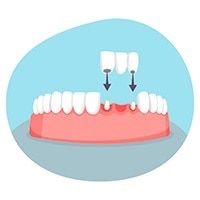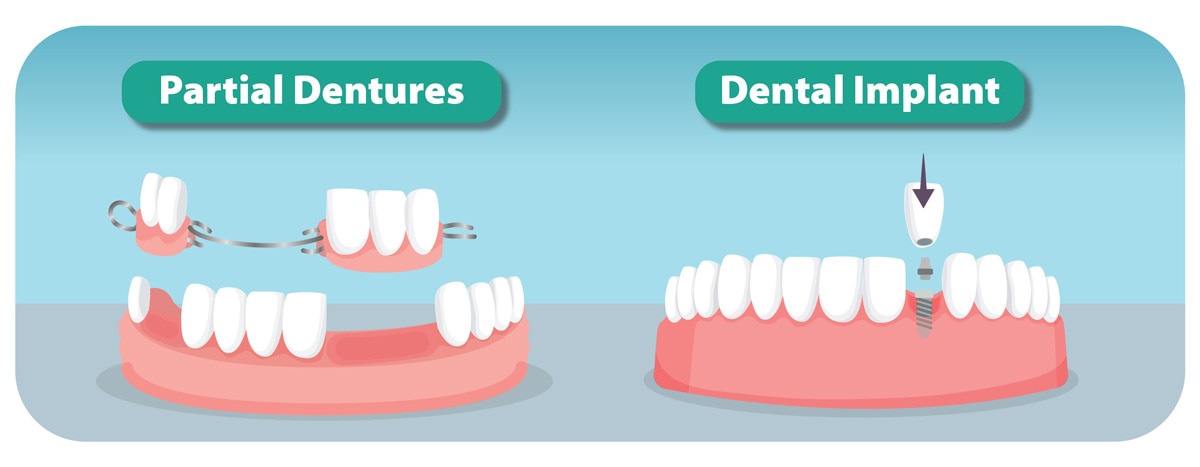
If you've never had a problem with your teeth or mouth, it's easy to take your adult teeth for granted. There are many reasons why someone might have a missing tooth — maybe they had an accident, tooth decay-related loss or even a congenital issue. Missing teeth might not seem like a serious health problem, but they can lead to facial changes and more significant problems like bone loss, malocclusion and even periodontal disease, which is where dental bridges come in.
What Are Dental Bridges?

A dental bridge is a prosthetic or artificial tooth that replaces a missing tooth in a person's mouth. The artificial tooth requires a natural tooth in front and behind in order for the prosthesis to be cemented to teeth adjacent to the space.
Benefits
While an individual may still be able to eat and function with one or more missing teeth, these gaps can have an adverse effect on your occlusion (bite), the way your teeth sit in your jaw and your facial structure. Not filling the gap can lead to problems chewing, aesthetics, speech issues and greater risks of periodontal disease and tooth decay. Additionally, without a tooth to fill the space in your jaw, the bone can shrink, which can change the way your mouth and face look.
Dental bridges are a way to replace missing teeth by creating artificial “teeth" through one of several methods.
Material
Dental bridges are made from a variety of materials, including:
-
Porcelain
-
Zirconia
-
Resin composite
-
Precious metals or gold alloys
The dentist will determine what type of materials to use and where to affix them based on factors such as the health of remaining teeth, if you clench or grind your jaw and what type of insurance coverage you have.
Lifespan
Dental bridges typically only last 5 to 10 years. This is because tooth-supported bridges don't stimulate natural bone growth, which can lead to deterioration over time. Additionally, many patients have difficulty flossing them, which leads to decay.
How Much Do Dental Bridges Cost?
The national average cost* for a traditional bridge is $5,197, but ranges between $4,100-$9,650 based on a variety of factors, according to CareCredit's 2024 Cost Study.1
Each dental bridge is typically composed of a “pontic" (the artificial tooth) connected to a cap for the adjacent teeth to which the bridge attaches. So to get an accurate sense of cost, you have to factor in the number of pontics and crowns, as well as the types of materials used, such as metal or ceramic or in the case of implant-based bridges, titanium, as well as surgical costs.
Cost by type of dental bridge
The price you pay for dental bridges is also impacted by the type of dental bridge you receive. Dental bridges come in four main types. Below is the average cost* per type:1
| Bridge type | Average Cost |
|---|---|
| Traditional | $5,197 |
| Cantilever | $1,041 |
| Resin-bonded (a.k.a. Maryland) | $1,569 |
| Implant Supported | $5,195 |
Additionally, traditional and cantilever bridges require some re-shaping of the adjacent teeth, which are then capped with crowns. A resin-bonded bridge, on the other hand, does not require as much — if any — shaping of adjacent teeth. This type of bridge is often used to replace front teeth, but may not last as long as traditional bridge work.
Dental bridge cost by state/district
Below is a breakdown of the average cost* for a traditional bridge depending on where you live in the U.S.1 Prices do not include the cost of a consultation, any potential ongoing maintenance or repair or potential insurance coverage.
| State/District | Average cost of a traditional bridge |
|---|---|
| Alabama | $4,561 |
| Alaska | $6,272 |
| Arizona | $5,283 |
| Arkansas | $4,456 |
| California | $6,483 |
| Colorado | $5,228 |
| Connecticut | $5,383 |
| Delaware | $5,189 |
| District of Columbia | $6,872 |
| Florida | $5,131 |
| Georgia | $4,656 |
| Hawaii | $8,011 |
| Idaho | $5,294 |
| Illinois | $5,406 |
| Indiana | $4,622 |
| Iowa | $4,600 |
| Kansas | $4,672 |
| Kentucky | $4,772 |
| Louisiana | $4,761 |
| Maine | $5,211 |
| Maryland | $5,944 |
| Massachusetts | $5,672 |
| Michigan | $4,744 |
| Minnesota | $4,872 |
| Mississippi | $4,500 |
| Missouri | $4,567 |
| Montana | $5,122 |
| Nebraska | $4,661 |
| Nevada | $5,150 |
| New Hampshire | $5,506 |
| New Jersey | $5,622 |
| New Mexico | $4,954 |
| New York | $5,744 |
| North Carolina | $4,800 |
| North Dakota | $4,750 |
| Ohio | $4,839 |
| Oklahoma | $4,506 |
| Oregon | $5,539 |
| Pennsylvania | $5,050 |
| Rhode Island | $5,594 |
| South Carolina | $4,789 |
| South Dakota | $4,694 |
| Tennessee | $4,700 |
| Texas | $4,806 |
| Utah | $5,222 |
| Vermont | $5,617 |
| Virginia | $5,028 |
| Washington | $5,678 |
| West Virginia | $4,644 |
| Wisconsin | $4,817 |
| Wyoming | $4,767 |
Materials and complexity are other factors that influence how much you pay for a traditional single tooth bridge. You will likely also need to pay for a dental exam and cleaning before getting a traditional single tooth bridge. If a bridge is part of a smile makeover involving other procedures, that can also impact the cost.1
Front Dental Bridge
Front teeth often lend themselves to a resin-bonded bridge or “Maryland" bridge, because these teeth are under less pressure than back teeth, and require less preparation of adjacent teeth. This will work so long as the gums are healthy and there aren't a lot of dental fillings in the adjacent teeth.
A dental bridge can replace one to four missing teeth anywhere in the mouth, though back teeth may require more teeth than front teeth to provide a solid foundation for the bridge's support. A bridge for the front teeth will work so long as:
-
The front portion of the mouth has enough teeth to anchor dental crowns.
-
The anchoring teeth are in good health and shape to support a bridge.
-
There are no more than four missing teeth. The fewer the teeth, the greater the stability of the dental bridge.
Costs for front dental bridges are the same as bridges anywhere else in the mouth.
Alternatives to Dental Bridges

If a dental bridge isn't the right solution, other options include removable partial dentures —replacement teeth attached to gum-colored plastic bases — and implants, which are artificial tooth roots surgically mounted directly into the jaw bone.
Partial dentures
Dentures can be taken in and out of the mouth, and often require dental glue. These can be less comfortable and not as effective as other kinds of prosthetics, though they can be made to look like real teeth and are more economical.
Implants
Dental implants are essentially prosthetic tooth roots — most commonly made from titanium and surgically mounted into your jawbone, to support either a crown or bridge. Dental implants are permanent, but more expensive and requires oral surgery. They do tend to provide better stability and durability for chewing and biting and longevity. Also, for some individuals who have bad oral health or have suffered significant bone loss, dentures or bridges may be the only options as their jaws may not be able to support implants.
Dental Bridge Procedure
Getting a bridge placed in your mouth typically requires more than one visit to the dentist. At the first visit, the dentist will administer a local anesthetic and then, if necessary, reshape the teeth adjacent to the missing tooth, preparing them down to very smaller versions, which the bridge will eventually be attached or cemented on.
The dentist will then take an impression of your teeth and send that to a dental laboratory, where technicians will make the permanent bridge to fit you perfectly. Meanwhile, you'll receive a temporary bridge to protect your teeth while you await the permanent one.
When your permanent bridge comes in, you'll return to the dentist to have the bridge cemented into place on the adjacent teeth. Most bridges cannot be taken out of your mouth once they are put in, except by a dentist.
Today, there are dental practices that have technology that can make a dental bridge in one appointment.
Bone Grafts and Dental Bridges
In some cases, a person may need a dental bone graft, which replaces missing bone in your jaw and encourages the bone to regenerate. Causes of bone loss include:
-
Aging
-
Missing teeth
-
Genetic defects
-
Untreated periodontal disease
-
Trauma to the jaw
The natural bone growth will eventually absorb the graft material and act like all new bone. Among other things, this can make the jaw more stable for receiving an implant-based bridge. It is estimated that half of implants first require a bone graft. One type of graft is an autograft, which uses bone tissue taken from another part of the patient's body. An allograft, which uses bone from the same species or cadaver, is the most common type of bone grafting procedure. These are readily available, successful and does not require another surgical wound like an autograft. A Xenograft, which uses bone from another species like a cow or horse, is also available. Additionally, synthetic bone is another option and has promise. A consultation with your dentist or surgeon to see if you are a candidate is recommended.
Aftercare for Dental Bridges
You can expect to feel some mild soreness around your bridge, as well as some sensitivity to hot and cold. Until these symptoms go away, it is recommended that you:
-
Stay away from hot and cold foods and drinks.
-
Avoid sticky, hard or crunchy foods.
-
Use an ice pack outside your jaw to reduce swelling.
Take over-the-counter pain and antibiotic medication as needed.
Financing Dental Bridges With the CareCredit Credit Card
Whether you're getting dental bridges or you're simply paying for a dental exam, the CareCredit credit card can help you pay for costs not covered by insurance.** Use our Acceptance Locator to find a dentist or oral surgeon near you that accepts CareCredit. Use the CareCredit credit card, again and again, to pay for your health and wellness wants and needs, and download the CareCredit Mobile App to manage your account, find a provider on the go and easily access the Well U blog for more great articles, podcasts and videos.
In addition to dental care, you can also use your CareCredit credit card for pet care, cosmetic, vision, hearing, health systems, dermatology, pharmacy purchases, spa treatments and so much more within the CareCredit network. How will you invest in your health and wellness next?
Expert Reviewer
Dr. Howard Ong, M.A.G.D.
Dr. Howard Ong is a general dentist who specializes in dental implants and is one of the partners and owners of Oaxaca, Ong & Jensen Seal Beach DDS, located in Seal Beach, California. Due to his extensive training, he handles all surgery cases for the practice and is a proponent of using cutting-edge technology in the office.
Author Bio
Jordan Rosenfeld has been freelance writing for 21 years about finances, health, education and more. Her work has appeared in The Atlantic, The Billfold, Good Magazine, GoBanking Rates, Daily Worth, Quartz, Medical Economics, The New York Times, Paypal, The Washington Post and more.






